To increase the amount of greenery surrounding your home, consider sowing grass seed in new locations on your lawn. Below is the ultimate guide on how to plant grass seeds.
You need to choose the right time of year, prepare the surface of the lawn, enrich your soil with nutrients to help grass seeds grow, lay and feed the grass seed, water appropriately, monitor seed establishment, mow and maintain.
If your current lawn is a little worn out, you can also sow fresh grass seed to improve it. Even completely reestablishing your lawn is possible with grass seed.
Continue reading.
Before You Start Planting Grass Seed
You should be familiar with a few fundamental concepts before learning how to plant grass seed.
- A healthy lawn needs good soil. The majority of turfgrasses favor neutral soils. To be sure that your efforts aren’t in vain, always perform a soil testfirst and make the recommended amendments.
- Don’t apply a weed preventer (liquid or granular) or use weed and feed fertilizer when growing grass. You can control weeds only after you’ve mown new grass seedlings at least four times. Any weed control measures used at the time of seeding will stop germination or kill young seedlings.
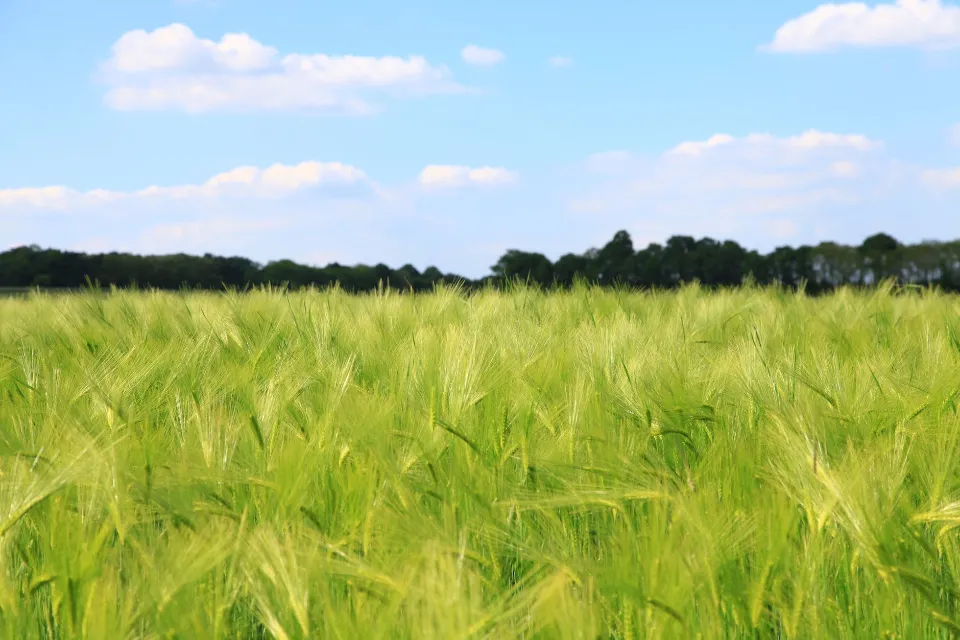
How to Plant Grass Seeds?
Here are the details:
Choose the Right Time of Year
The success of grass seed is directly related to the time of year it is planted. Proper timing helps ensure your grass seed will germinate properly, grow quickly and remain healthy while new seedlings become established. Let’s find the best time to plant grass seed.
When to plant grass seed? The best time to plant grass seed varies according to your grass growing region and the type of grass you grow. Lawns across the northern tier of the United States typically consist of cool-season grasses, such as Kentucky bluegrass, tall fescue or perennial ryegrass. The best growth times for these grass types are in the fall and spring, when it is cool outside.
The best time to sow grass seed in Massachusetts, for instance, is early fall. Even though the days are now cool and occasionally rainy, the ground is still warm enough to encourage germination. Newly planted seeds are kept from drying out thanks to this mixture. Early fall also offers enough daylight for new grass to flourish and take root before the onset of winter.
For planting cool-season grasses, spring seeding is your second-best choice. Try to sow as early in the season as possible, but hold off until daytime highs of 60 to 75 degrees Fahrenheit. The ideal soil temperatures for cool-season grass seed germination are roughly corresponding to this. Strong grass growth is aided by both spring rain and sunshine.
For lawns in the southern half of the United States., warm-season lawn grasses such as Bermudagrass, Zoysia grass, Bahiagrass and Centipede grass are the rule. The best time to plant these grasses is in the spring or early summer, as opposed to the fall, when they grow the fastest. Wait until daytime temperatures are near 80 degrees Fahrenheit or higher and there is no longer any risk of a late spring frost in your area before planting warm-season grasses. But, how to sow grass seed in the winter?
To develop your lawn maintenance strategy, learn how to identify crabgrass. Below will give you a full explanation of what is crabgrass.
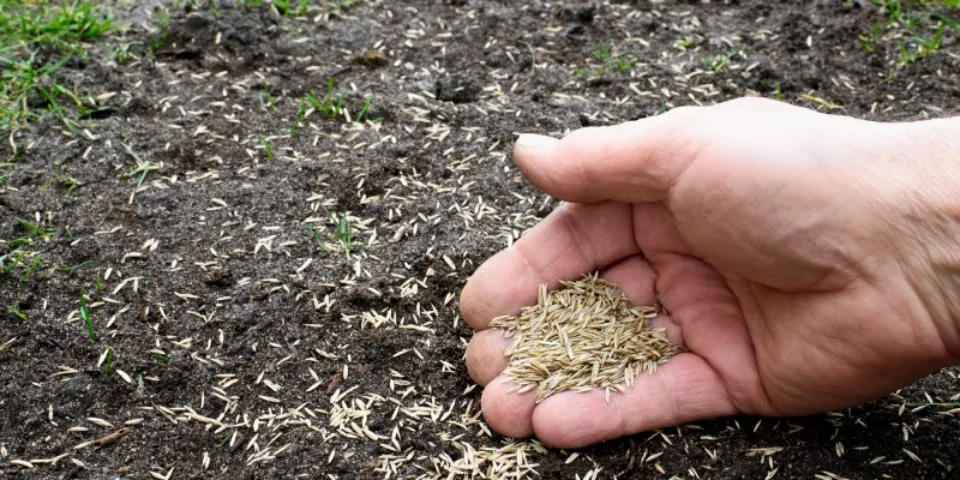
Prepare the Surface of the Lawn
Make sure you have a good, solid foundation before you begin seeding, whether you are doing it for the first time or simply overseeding your already thinned-out lawn. Make sure to clear the lawn of weeds, rocks, sticks, and other objects.
Before planting any seeds, look for any areas of uneven ground and attempt to level it. This will lessen the likelihood of water gathering and pooling in low areas, which would otherwise cause the seed to rot.
Loosen the soil
If your soil is compacted, you will need to loosen at least the top four inches of soil. A tiller or rake are options. The best opportunity for healthy growth will be given by allowing air to flow.
Adding a thin layer of topsoil to the lawn at this point is also an option. Freshly laid material won’t be compacted, allowing for good airflow. Make sure to leave enough for coverage at the end.
Applying topsoil to the lawn will also level it out for a nice, even appearance, which will also help you prevent puddles when you water. If there are any divots or holes, now is a good time to fill them in so that there are no issues later on when the grass starts to grow.
Read about:
Enrich Your Soil With Nutrients to Help Grass Seeds Grow
If your lawn is dying or having trouble growing, there may be deeper soil problems that need to be resolved before you plant new grass seed.
You’ll need to take your pH tester out at this point. For most types of grass, the ideal pH range is between 6.0 and 7.0.
Your soil is too acidic if its pH is lower than 6.0, which means it needs nutrients like calcium, phosphorus, potassium, and nitrogen. Lime (aka limestone) can be applied to the soil to help increase the soil pH and make those nutrients more available.
If your soil’s pH is above a 7, add compost, peat, sulfur, or fertilizer to lower the pH.
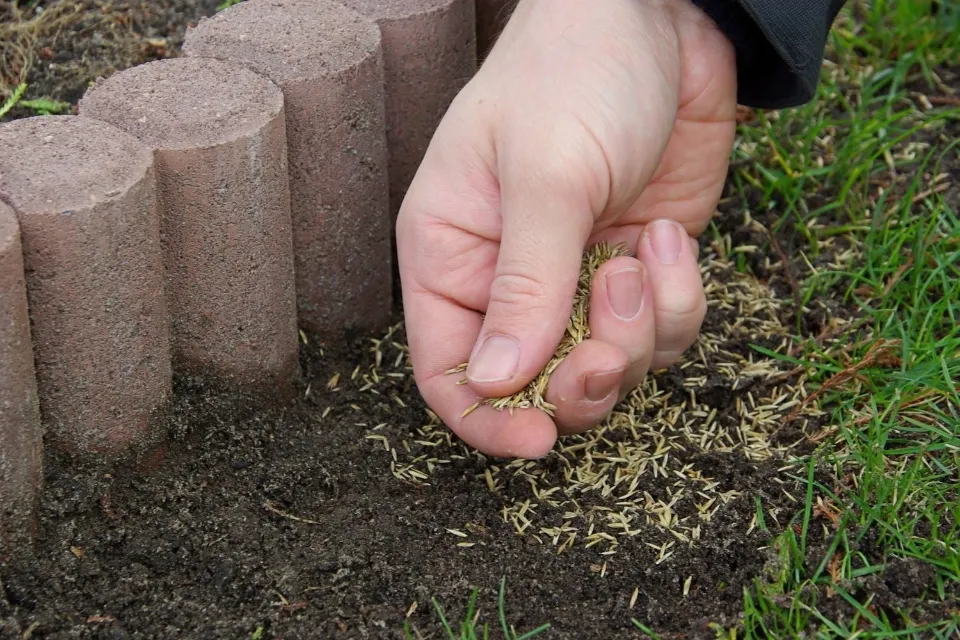
Lay and Feed the Grass Seed
A brand-new lawn requires a fairly heavy application of seeds when being seeded. To ensure that everything is covered, try to apply the product evenly over the entire area.
As an alternative, when overseeding an existing lawn, you need a lighter coverage. To encourage growth, spread out more grass seed in bare spots.
Simply use your bare hands to spread the seed, or a spreader for larger areas. But, How to Grow Grass Fast?
Cover Up the Seeds Or Work the Seeds into the Soil
If seed is only sown on the ground’s top layer, it will quickly dry out and not take root. Additionally, water or wind could wash it away.
To bury the seeds, spread a further, thin layer of the soil you bought over your lawn.
The seed must be worked into the soil between 13 and ½ of an inch deep if you do not have soil to cover the seeds with. After planting the seed, rake the soil to even out the surface and work the seed into the ground.
As a result, the water won’t evaporate right away, keeping the ground moist. The seeds are also safeguarded from animals by it.
Add Your Feeder
Apply fertilizer to the yard after planting the seed to hasten the growth.
Water Appropriately
In order to successfully seed grass, it is essential to keep grass seeds and seedlings moist but not soggy all the time. So, how often to water grass seed? How often to water new grass seed? To keep the seeds moist, lightly mist newly seeded areas two to three times daily. When puddles start to form on the soil’s surface, stop watering. Gradually switch to less frequent but heavier watering once the grass seeds germinate and seedlings start to grow. As the grass gets older and taller, watering should decrease gradually. Read more: How Long to Water New Grass Seed?
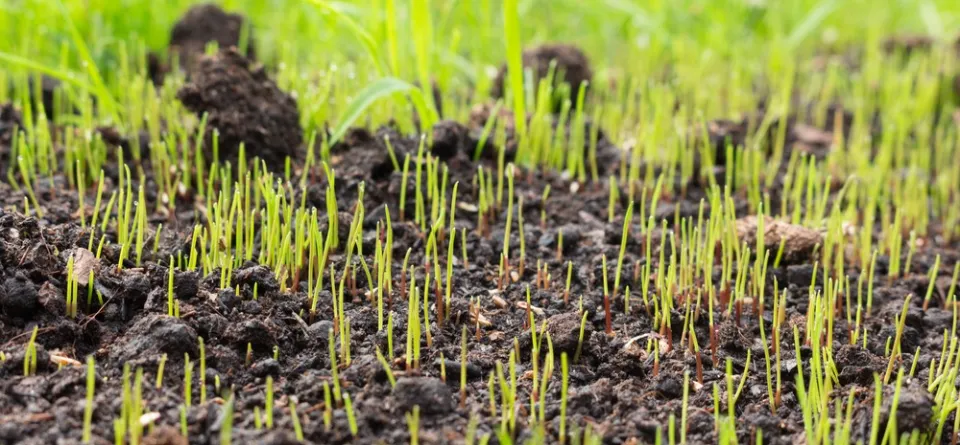
Monitor Seed Establishment
To begin with, how long does it take for grass seed to grow? Germination can take five to 21 days, depending on the type of grass you’re growing. Expect it to take your new grass an additional four to ten weeks to establish itself. Most grasses need an entire season to develop to the point where they are prepared for regular foot traffic.
Check the newly seeded area for any bare spots or areas you might have missed once your new seedlings are about an inch tall. When the new seedlings are thick and you are happy with the results, reseed the bare areas and repeat the procedure as necessary. Read more: Will Grass Seed Germinate on Top of the Soil?
Mow and Maintain
Your grass is prepared to withstand mowing once it reaches a height of 3 inches. Always follow best practices for mowing lawns, including the recommended mowing heights for your type of grass. Never remove more than one-third of the grass blade in a single mowing or you can stress your grass and invite lawn disease, lawn weeds and weak growth. Your first mowing of cool-season lawns planted in the fall might have to wait until the following spring.
Avoid as much foot traffic as you can during the first season after establishment because young grass is still delicate. Regular maintenance, including irrigation, will keep your grass growing healthily. In normal circumstances, your lawn will receive about 1 inch of water per week by way of rainfall supplementation. Read about: Can You Mow Wet Grass?
Feed cool-season lawns four to eight weeks after seed germination, but no later than November. Refrain from fertilizing your new lawn with warm-season grasses until the following spring. Depending on the results of your soil test, you may need to fertilize up to four times a year after initial feedings. Every three to four years, retest the soil and make necessary adjustments.
Read more:
How to Read Grass Seed Labels?
State laws require labeling on grass seed. Be sure to carefully note the following information on the label:
- The amount of the named variety by percentage of weight
- Other crop seeds in the package by percentage of weight
- Any inert ingredients in the package by percentage of weight
- Percentage of weed seed in the mixture (if any)
- The germination rate of the seed (a higher number means a better chance that each seed will germinate)
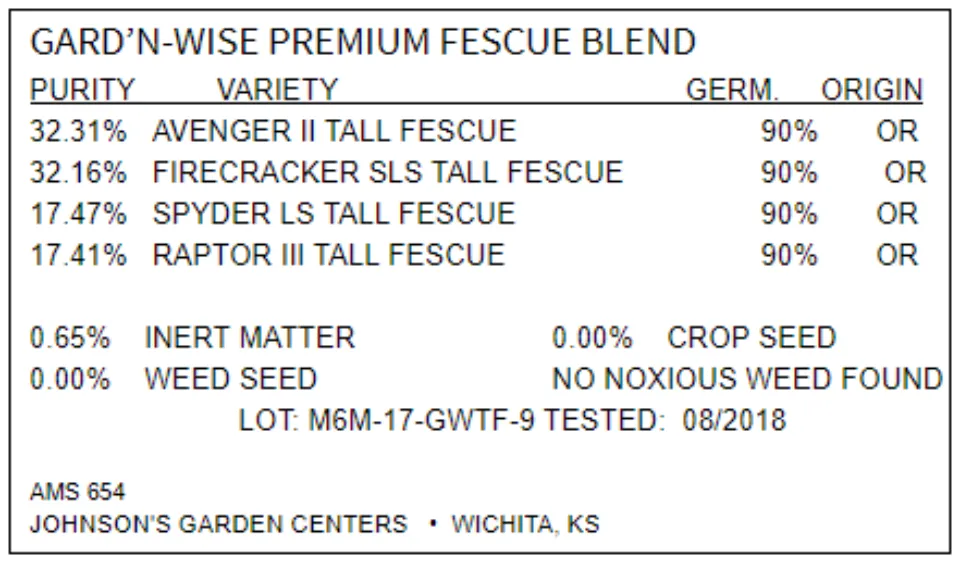
Find the best grass seed for your lawn by comparing different features and characteristics. The most common turfgrasses and how to apply them are listed in the following paragraphs.
How to Water New and Established Lawns?
For newly seeded lawns to germinate, water them lightly and frequently. Prior to the new seedlings reaching a height of about 1 inch, keep the soil moist (but not saturated). The seeds may rot or be washed away by too much water, so take care.
After your grass is established, remember these tips to keep your lawn adequately watered:
- If you can, drink water in the morning. The lack of wind minimizes evaporation and the chance for fungal diseases. But if you notice that the garden or lawn is under stress or in danger due to a lack of water, go ahead and water right away. On windy days, avoid using sprinklers to water the lawn.
- Instead of watering them on a strict weekly schedule, water lawns as needed. As a result, lawns become more tolerant to drought and weather patterns that mimic nature.
- Deeply water plants and let the soil partially dry in between applications. As a result, root growth will be encouraged. Turfgrass that has a robust root system is more resilient. Water is needed in the soil, but light, shallow sprinkles evaporate before they can do so.
- To improve the soil’s ability to absorb water, remove lawn thatch and aerate as required.
- If you have an underground sprinkler system, keep it adjusted and well maintained.
- Find any areas that are vulnerable to runoff and erosion, and make necessary repairs.
Those who are interested in lawn care start to wonder “how often should you water your lawn in the summer?” to make sure their lawn stays lush and green throughout the rest of the year.

How Long Does Grass Seed Last?
How long does grass seed last? The lifespan of grass seed is influenced by the crop’s quality, growing environment, species, and storage method. Find out below how to tell when grass seed is bad.
If stored properly, the lifespan of grass seeds varies from 18 months to 5 years, depending on the variety you choose and whether you open the package.
- Grass seed can last up to five years if it is kept properly sealed and unopened.
- Open grass seed can last up to 18 months when stored properly.
How long does grass seed last in a bag? In short, grass seed lasts two to three years in an open bag if your roll it up and seal it as much as possible.
FAQs
How Long Does New Grass Seed Take to Grow?
In general, grass seed germination starts between 7 and 30 days after planting.
Can You Just Sprinkle Grass Seed on Top of Your Existing Lawn?
While it is possible to simply spread the new grass seed over your current lawn, spending the time to prepare your lawn beforehand will improve your results and increase the likelihood of seed germination.
Will Grass Seed Grow If I Just Throw It Down?
Most likely not; while some seeds on the soil’s surface will sprout, the rate of germination will decrease, and you won’t get the best results.
Will Grass Seed Germinate on Top of Soil?
How loose your soil is a factor. Grass seeds are not robust enough to penetrate soil. They are intended to be set on top of loose, prepared soil. Too much soil on top of them can quickly hinder germination.
Summary: How to Plant Grass Seed?
You need to choose the right time of year, prepare the surface of the lawn, enrich your soil with nutrients to help grass seeds grow, lay and feed the grass seed, water appropriately, monitor seed establishment, mow and maintain.
Planting grass seed is a simple project that can completely transform your yard if you choose the grass that is best suited for your area and the conditions of your lawn and follow these easy instructions. Pennington is committed to giving you the tools and top-quality products you need to produce lush, lovely turf.
If you have any questions, please leave a comment. My Prime Home tries to give you the best home improvement information. Thank you for reading.
Read about


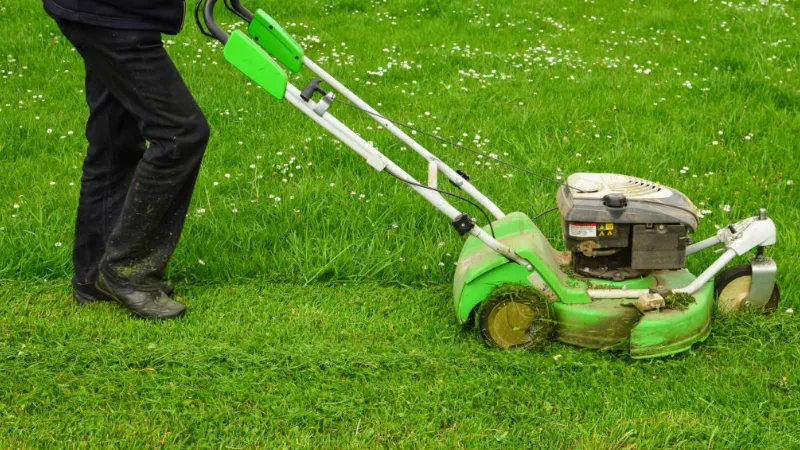
![Best Grass Seed: How to Choose [2023]](https://www.myprimehome.com/wp-content/uploads/2023/02/Best-Grass-Seed-How-to-Choose-2023.webp)